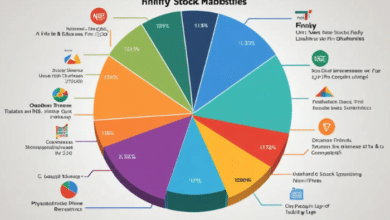
The FinNifty chart is a graphical representation of the price movement and trends of the Nifty Financial Services Index (FINNIFTY) on the NSE (National Stock Exchange) in India. FinNifty is an index that captures the performance of the financial services sector, which includes major banking, insurance, and financial institutions. Traders and investors use the FinNifty chart to analyze trends, identify potential entry and exit points, and make informed trading decisions.
FinNifty charts display real-time data, allowing traders to observe how the financial sector performs relative to other indices. With the FinNifty chart, one can analyze the financial health of various sectors and understand market sentiment. This chart is particularly useful for those who want to focus on finance-centric stocks and monitor economic cycles affecting the financial industry.
Why is the FinNifty Chart Important for Traders?
The FinNifty chart is crucial for traders because it offers insight into the performance of the financial sector. Given that financial services play a central role in the economy, the FinNifty chart can act as a gauge for market sentiment. When financial stocks are on the rise, it often signals economic stability or growth, while declines may indicate economic downturns.
For traders, the FinNifty chart can serve as a vital tool for making sector-specific trades. By monitoring this chart, traders can capitalize on short-term price movements, apply technical analysis techniques, and strategize their trades based on real-time data. The FinNifty chart also enables traders to manage risks, as it provides data on market conditions, helping traders avoid trades during times of high volatility.
How to Read the FinNifty Chart
Reading the FinNifty chart requires an understanding of various indicators and patterns. The FinNifty chart is typically divided into time intervals, such as 1 minute, 5 minutes, daily, weekly, or monthly, depending on the trader’s preference. By examining these intervals, traders can observe trends and fluctuations, enabling them to make better-informed trading decisions.
Price bars, candlesticks, or line charts are common forms of the FinNifty chart, with candlestick patterns being one of the most popular among traders. A candlestick chart helps traders observe opening and closing prices, as well as highs and lows for each interval. By interpreting these patterns on the FinNifty chart, traders can predict potential future price movements, determine trends, and identify reversal signals in the financial sector.
Analyzing Trends on the FinNifty Chart
Trend analysis is an essential skill when interpreting the FinNifty chart. Trends are the general direction in which prices are moving over a particular period. Identifying an upward trend on the FinNifty chart signals a bullish market, suggesting that prices are expected to rise. Conversely, a downward trend indicates a bearish market, with declining prices.
To spot trends on the FinNifty chart, traders often use moving averages, which smooth out price data to show the underlying direction. The 50-day and 200-day moving averages are commonly used to assess medium and long-term trends. When the short-term moving average crosses above the long-term average, it’s a bullish signal, while the opposite crossover indicates a bearish trend. Recognizing these trends allows traders to make strategic decisions based on market conditions.
Using Technical Indicators on the FinNifty Chart
Technical indicators are tools that help traders analyze the FinNifty chart. Some commonly used indicators include the Relative Strength Index (RSI), Moving Average Convergence Divergence (MACD), and Bollinger Bands. Each of these indicators provides unique insights into the price action and helps traders make informed decisions.
The RSI on the FinNifty chart, for instance, measures the strength of price movements and identifies overbought or oversold conditions. Values above 70 suggest that the asset is overbought, while values below 30 indicate an oversold condition. MACD, on the other hand, reveals changes in momentum and can signal trend reversals, while Bollinger Bands help traders gauge market volatility. By using these indicators on the FinNifty chart, traders can better understand market conditions and identify potential trading opportunities.
FinNifty Chart Patterns and What They Mean
Chart patterns are formations created by price movements on the FinNifty chart. These patterns help traders predict future price action based on historical behavior. Common patterns observed on the FinNifty chart include head and shoulders, double tops and bottoms, flags, and triangles.
The head and shoulders pattern, for instance, indicates a potential reversal after an uptrend, while double tops signal a bearish reversal. Flags and triangles are continuation patterns, suggesting that the trend will resume after a period of consolidation. Understanding these patterns on the FinNifty chart allows traders to anticipate market moves and make informed decisions.
Day Trading with the FinNifty Chart
The FinNifty chart is a popular tool for day traders who focus on intraday price movements. By analyzing short-term trends, day traders can capitalize on price fluctuations within the same trading day. The FinNifty chart provides a detailed view of minute-by-minute price changes, enabling day traders to take advantage of small price movements.
Day trading on the FinNifty chart requires a solid understanding of technical analysis and quick decision-making skills. Traders often use indicators like RSI, MACD, and Bollinger Bands to confirm entry and exit points. Since the financial sector is sensitive to economic news and reports, day traders also monitor news events that can affect FinNifty’s performance. By combining technical analysis with market awareness, day traders can leverage the FinNifty chart to identify profitable trades.
Swing Trading with the FinNifty Chart
Swing trading on the FinNifty chart involves holding positions for several days to weeks, taking advantage of short- to medium-term trends. Swing traders analyze the FinNifty chart to identify price patterns and trends, allowing them to make trades based on expected price movements.
Swing traders rely heavily on technical analysis and indicators like moving averages and MACD to identify trends on the FinNifty chart. By observing patterns and signals, swing traders can enter trades at favorable points and hold positions to capture profits as prices move. Swing trading on the FinNifty chart allows traders to benefit from both upward and downward trends, making it an attractive strategy for those looking for flexibility in trading.
FinNifty Chart for Options Trading
Options trading on the FinNifty chart is an effective strategy for traders who want to leverage price movements without directly owning the underlying assets. The FinNifty index options offer flexibility and risk management features, as traders can speculate on the financial sector’s performance without committing to buying individual stocks.
When trading options on the FinNifty chart, traders use technical indicators and chart patterns to anticipate price movements. Analyzing the FinNifty chart can help traders identify optimal strike prices and expiration dates, enabling them to make strategic options trades. Options trading with the FinNifty chart also allows for hedging, giving traders the ability to manage risk and protect their investments in volatile markets.
Key Tips for Using the FinNifty Chart Effectively
Using the FinNifty chart effectively requires a strategic approach and a thorough understanding of technical analysis. One of the best practices is to combine multiple indicators and chart patterns to confirm signals. For example, pairing the MACD with moving averages can improve accuracy when identifying trends.
Traders should also monitor the overall market sentiment, as financial stocks are sensitive to economic changes. News and reports related to the financial sector can cause significant price swings on the FinNifty chart, so keeping an eye on market news is essential. Additionally, practicing risk management and setting stop-loss orders can help traders protect their investments when trading on the FinNifty chart.
Conclusion
The FinNifty chart is a valuable tool for traders and investors focusing on the financial sector. By analyzing trends, patterns, and indicators on the FinNifty chart, traders can make well-informed decisions, capitalize on short- and medium-term price movements, and manage risks effectively. Whether you’re a day trader, swing trader, or options trader, understanding how to interpret and utilize the FinNifty chart can enhance your trading strategies and improve your success in the market.
FAQs
Q1: What is the best time frame to use on the FinNifty chart?
A1: The best time frame depends on your trading style. Day traders may use 1- to 5-minute charts, while swing traders prefer daily or weekly charts.
Q2: Can the FinNifty chart predict future price movements?
A2: While the FinNifty chart can provide insights into trends and patterns, it cannot guarantee future price movements. Technical analysis is based on probabilities, not certainties.
Q3: Is the FinNifty chart suitable for beginners?
A3: Yes, beginners can learn to use the FinNifty chart, but understanding technical indicators and patterns is essential for accurate analysis.
Q4: Can I use FinNifty charts for long-term investments?
A4: While FinNifty charts are primarily used for short- to medium-term trading, they can also help long-term investors assess sector trends.
Q5: Do I need advanced software to access the FinNifty chart?
A5: No, many trading platforms provide access to the FinNifty chart and basic analysis tools, so advanced software isn’t required.





